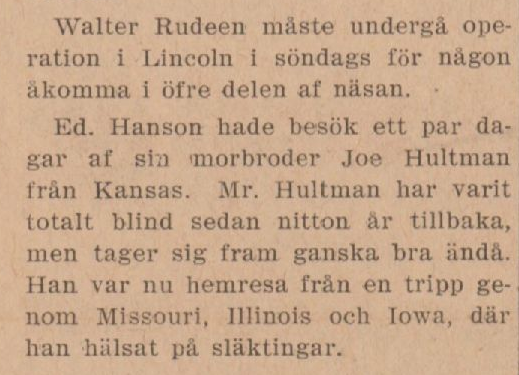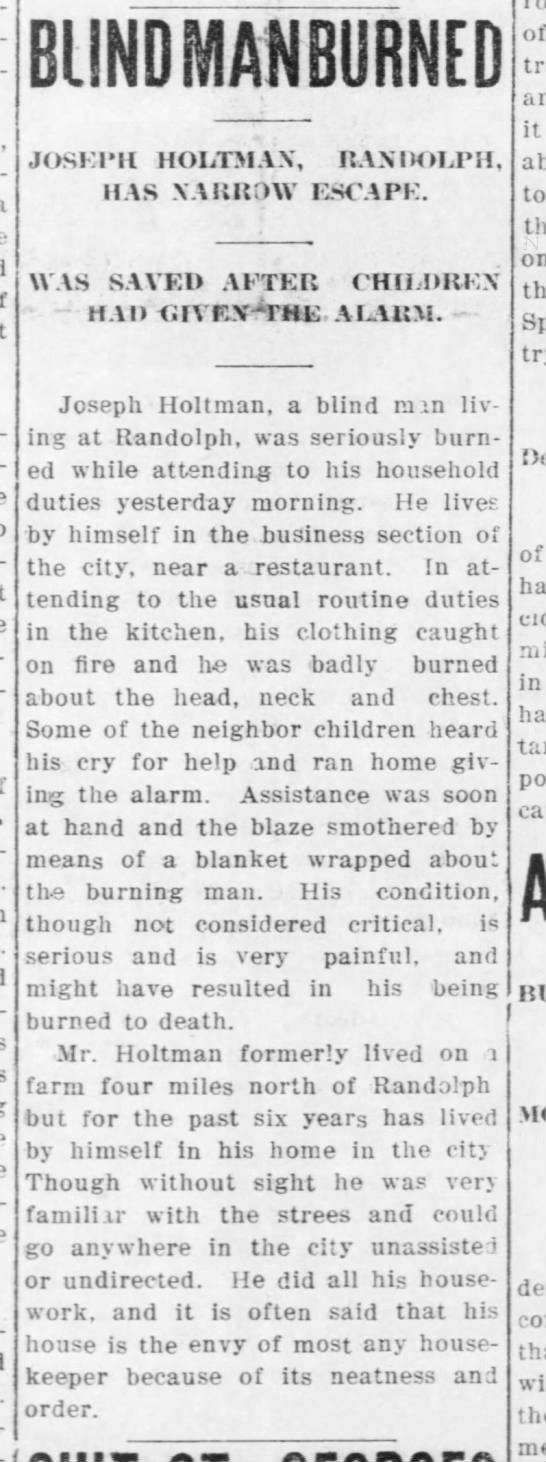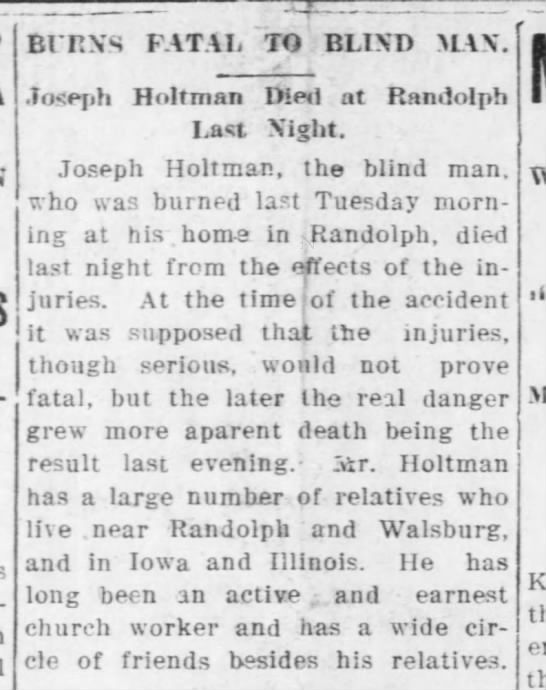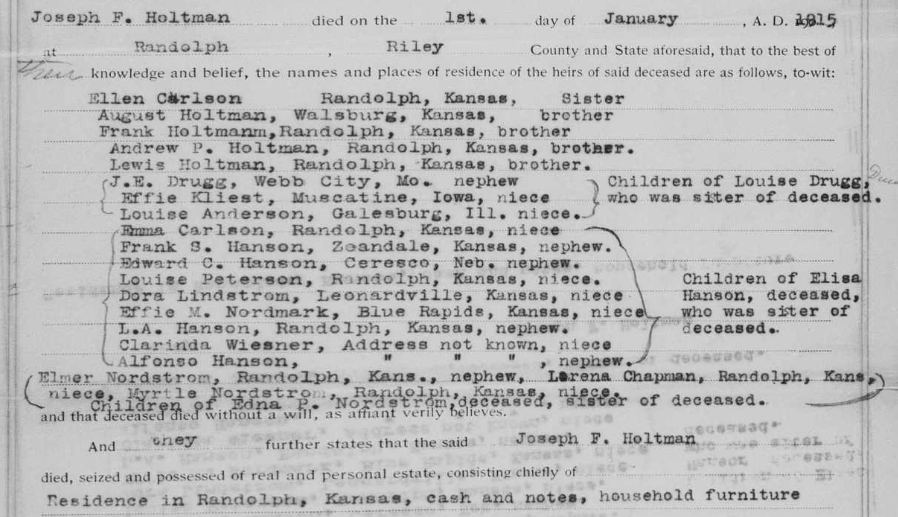Although Edward had made a life for himself in Saunders County, Nebraska, he still maintained close contact with his family back in Kansas. Here’s an interesting fact: to get from Ceresco to Randolph, you go south on Highway 77 and stay on it for 130 miles. That’s all there is to it!
Let’s get caught up on what was happening with the Hanson family during Edward’s early years in Nebraska. Last time, we examined the Hultman family as they moved from Illinois to Kansas and settled in the Swede Creek Township near Randolph. During this same period, the Hanson family experienced some major changes too.
At some point in early 1890’s, the family gathered for a portrait:
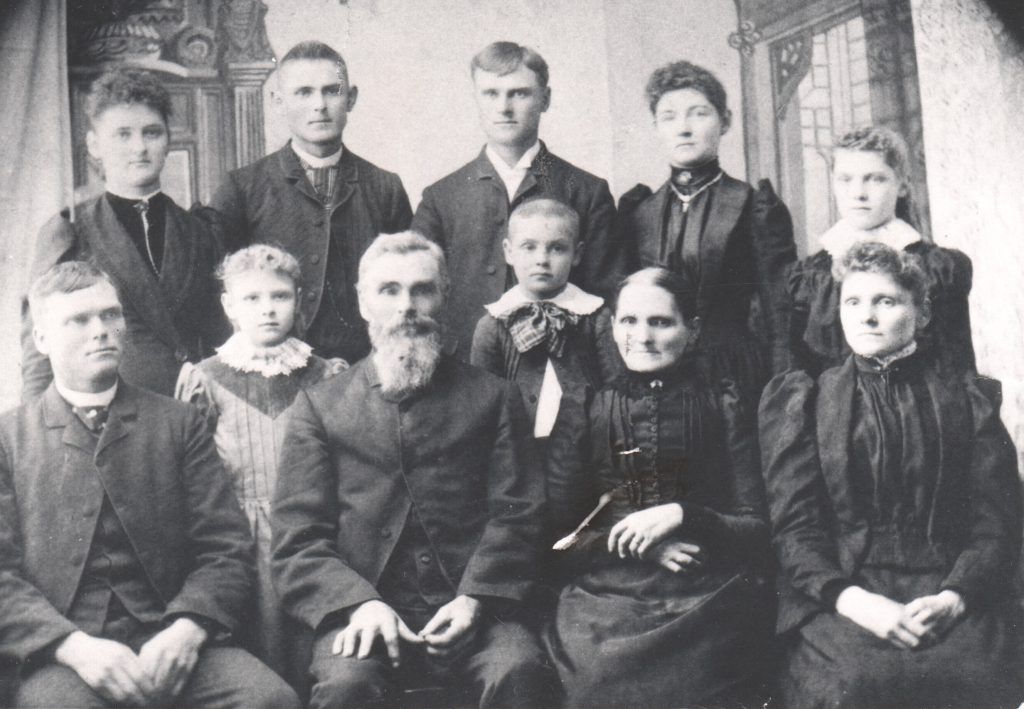
Back: Louise Juliana, Louis Alfred, Edward Cornelius, Edna MeDora, Effie Marie
Front: Franklin Solomon, Ester Clarinda, Louis, Alfonso Emanuel, Lisa Stina, Emma Carolina
Louis Hanson died in 1895 at the age of only 64. I was able to confirm this in a record source that I only recently learned about. There is a giant collection of digitized Swedish-American newspapers available through the Minnesota Historical Society. It is one of the best digitized newspaper collections that I’ve come across, and they even provide translation tools!
For example, in the February 12, 1895 issue of “Svenska Amerikanaren”, we find his death notice as follows:
What’s great about this is it tells us not only the date of death and his age, but also the parish, Hanebo, that he was born in! This would be great for researchers who don’t know where their ancestors came from. (By the way, I have hardly had to do any digging at all to find out where my Swedish ancestors came from. Their home parishes were either preserved in family records or available in the records of the Swedish churches in Ceresco and Swedeburg. I can tell you that most folks with Swedish ancestry aren’t this lucky!)
Svenska Amerikaneren was an Illinois newspaper. I would have never thought to look for Louis Hanson’s obituary in Illinois. The family in Kansas must have wanted their friends still back in Illinois to know of this news.
An obituary also ran in the local newspaper, this one in English:
I notice that “Ed. Secrest” contributed to the obituary. I recognize his name as one of the early settlers and founders of Randolph; quite a tribute for him to recognize Louis this way. There were other articles in the Randolph newspaper in the 1880’s that recognized Louis as an alternate delegate to a couple of local Republican conventions. He also got a 1st place ribbon at the Riley County Fair in 1882 for his “broom corn”.
Until I start working on this series of blog posts, Louis Hanson was sort of a “blank” in my family tree. Now that I’ve gotten to know him better, I am so very proud of him! He seems like a hard-working, industrious and smart guy and seems to have been a good father and husband. I think that because he died before my grandmother was born, there wasn’t much in the way of family lore that could be passed down.
Four years later, Lisa Stina passed away at a very young age of 56 (yikes, that’s how old I am right now!) From the Randolph Enterprise:
“As noticed last week, Mrs. Eliza Hanson died April 11. She was born in Sweden December 29, 1842. She came to this country with her parents, Mr. and Mrs. J. R. Holtman, in 1854, and settled in Illinois, where in 1859 she was married to Lewis Hanson and resided in Illinois until 1865, when they emigrated to Kansas and in 1867 settled on their homestead one mile west of Randolph, where they lived happily and reasonably successful, although enduring many struggles of the early settlers until April 24, 1888, when they moved to Randolph and settled in their home in the north end, that they might have better school advantages for their children and spend their own declining years more quietly and comfortably.
Here they lived pleasantly till January 30, 1895, when the husband and father passed away from all earthly joys and sorrows. Since then Mrs. Hanson has been in declining health, bearing all with patience and Christian fortitude. Eventually she has gone to join her husband. She leaves four sons and five daughters to mourn the loss of a kind and loving mother, besides and aged father and five brothers and two sisters. May she rest in peace as one who has faithfully earned her reward. F. H.
I saw another Randolph newspaper article from 1882 that mentioned her recovery from a serious illness and getting around on crutches – she would have been only 40 years old at that time, and still in her child-bearing years. I wonder if she had some form of arthritis or something like that? She looks kind of frail in the family photo, and her face is sunken as though she has missing teeth (they say that back in the day, women lost a tooth for every child they had).
Both Louis and Lisa Stina were buried in the Randolph Cemetery that had to be re-located when the Tuttle Creek Dam and flood control project was built. I visited the relocated cemetery a couple of years ago and found their stately tombstone and those of some their children. Their inscriptions are on adjacent sides of the tombstone. You can click on the images below to better read the inscriptions.
Lisa Stina’s father, Jonas P. Hultman, outlived his daughter. He passed away in October, 1903. I have transcriptions of two obituaries that appeared in the Randolph Enterprise (I’ll explain the Holtman/Hultman spelling thing next time):
Randolph Enterprise, Thursday, October 15, 1903:
Grandpa Holtman Dead.
“J. P. Holtman died at his home in the Rose Hill neighborhood Saturday morning, October 10, 1903, at the advanced age of 91 years, two months, and ten days.
Funeral services were held Tuesday afternoon and the body buried in the Rose Hill cemetery.
Mr. Holtman was a native of Sweden but had lived in this country a good many years, having made his home on a farm a few miles from Randolph for nearly a quarter of a century.
He leaves a number of sons and daughters, besides a large number of grandchildren and great-grandchildren. Those of his children with whom many of our readers are acquainted are Mrs. N. P. Nordstrom and Lewis Holtman of Randolph, Frank and Joseph Holtman of Rose Hill, and August Holtman of Walsburg and Andrew Holtman, now of Latham, Kansas.”
Randolph Enterprise, Thursday, October 22, 1903:
“J. P. Holtman, Whose death we noted last week was born in Sweden Aug. 1, 1812. He was married to Marie Johnson in 1836 who died about two years later leaving a daughter who is now Mrs. John Carlson of Rose Hill. On May 10, 1840 he was married again to Anna C. Johnson, a sister of his former wife, who died at Rose Hill Feb. 22, 1890, leaving five sons and three daughters, two of the daughters, Mrs. Drug of Illinois and Mrs. L. Hanson of this city having since died. All of the sons are yet alive. Mr. Holtman came to Illinois in 1854, where he lived twenty-nine years, coming to Kansas in Sept., 1883, and settled on the farm at Rose Hill, where he lived until his death. In his earlier life he filled many places of trust and importance both in his native and adopted countries, in a true and credible manner. He was converted in the year of 1857 and joined the Methodist Episcopal church of which he since remained an earnest faithful member, always desiring to see the welfare of the church as well as those nearest and dearest to him. Through all experiences of ups and downs in life he bore everything with patience and Christian fortitude, saying all would be well in the end. And he was not disappointed when departing this life at a ripe old age. He left five sons and two daughters and thirty seven grandchildren to mourn the loss of a kind, loving old father and grandpa who hope for reunion where all is joy.”
The death of Jonas meant that his son, Joseph, who had always lived with his parents was now alone. So what’s up with Joseph?
Joseph Hultman
Joseph was one of Lisa Stina’s younger brothers. He never married and always lived with his parents. The 1900 census stated that he could neither read nor write. I drew the mistaken conclusion that he must have had some sort of mental or developmental disability. Not so!
In the 1910 census, we find him living alone in the town of Randolph, no longer on the farm. By now, both of his parents have passed away. The census records show that he owns his home free and clear (no mortgage) and lives off his own income. He can read and write.
He is also blind.
I looked up the instructions for the census-takers in 1910. Unlike in the 1900 census, if someone was blind, the census-taker was to ask the person whether he could read or write before he became blind. So apparently Joseph was not blind from birth.
The Swedish Newspaper collection comes to the rescue with some additional details. This is from the Ceresco column* of the February 11, 1911 issue of the Omaha-Posten and there are news tidbits about TWO of my relatives:
Here is the Google translation:
Walter Rudeen must undergo surgery in Lincoln on Sunday for an ailment in the upper part of the nose.
Ed Hanson had a visit a few days of his uncle Joe Hultman from Kansas. Mr. Hultman was been totally blind since nineteen years, but manages pretty good anyway. He was now returns home from a trip through Missouri, Illinois and Iowa, where he visited relatives.
The article implies that he is traveling alone! Can you imagine! And I wonder what was the cause of his blindness? My guess is that it would be something like scarlet fever or measles or something like that. There were lots of diseases back then, easily treatable today, that could leave you permanently blind. (And poor Walt, having his nose surgery publicized all over Nebraska!)
Here is a close-up of Joseph from the Hultman family portrait. I had never really focused on him before.
Looking through the online newspapers from nearby Manhattan, Kansas, there are actually lots of news snippets about Joseph traveling here and there to visit out-of-state relatives, and relatives coming to visit him, too. He is also mentioned one time as being the President of the Jackson Township at the Riley County Sunday School Convention!
Here are two more articles about Joseph, the first from December 30, 1914 and the second just three days later on January 2, 1915.
What a terribly sad ending to a remarkable life.
His probate records are available on familysearch.org and they are a goldmine of genealogical information. His survivors are named along with their relationships and place of residence. This fills in a lot of gaps in the family tree!
Joseph’s next youngest brother, Frank, handled the estate. My great-grandfather Edward, who was Joseph’s nephew, ended up with 1/9th of a 1/8th share which amounted to less than $20.
Deeper in the file is a hand-written letter from Frank to the judge explaining that he couldn’t figure out how to divide up the last 17 cents so he decided to keep it himself to offset his postage expenses.
The next and final installment will give a brief epilogue about each of the Hultman and Hanson children.
*get ready for lots of future blog posts about the news snippets I found in the Omaha-Posten for Swedeburg and Ceresco. What fun!


